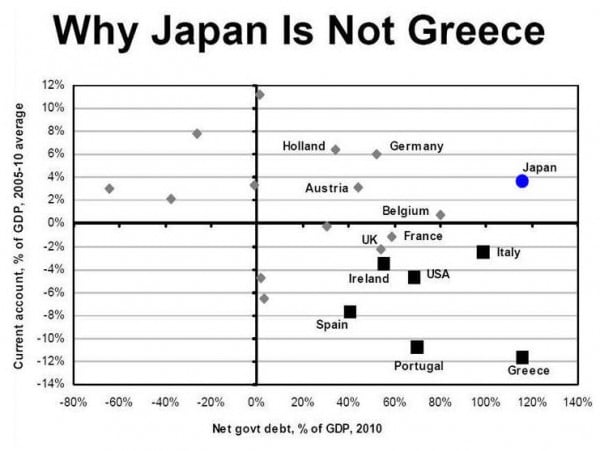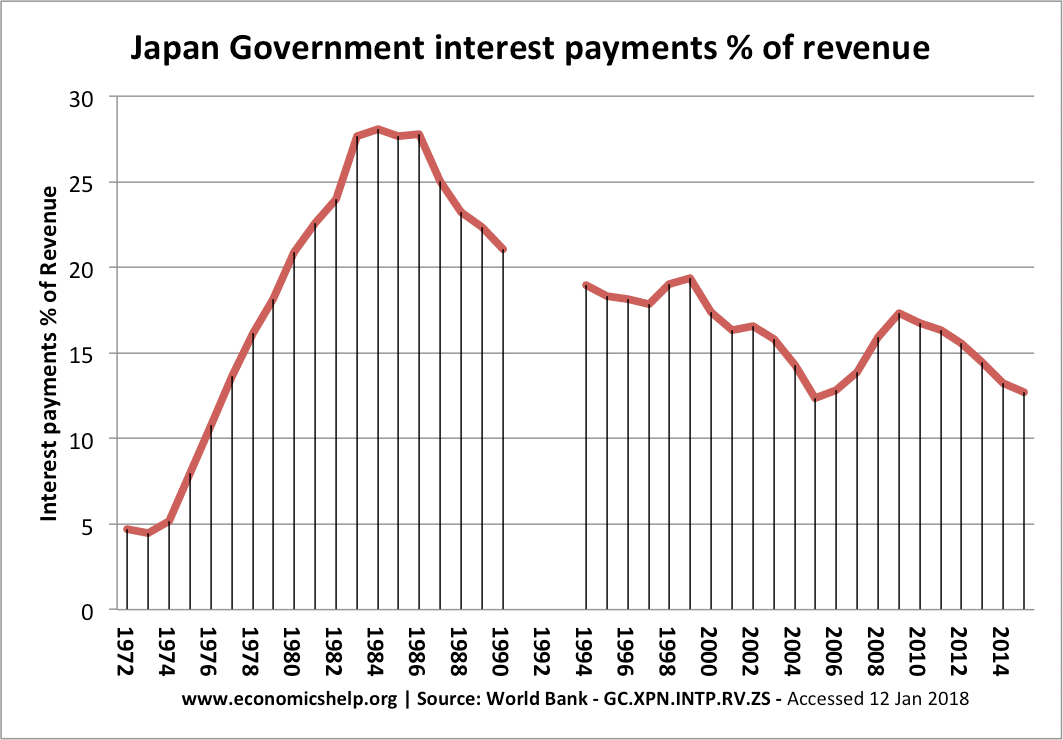Readers Question: How is Japan able to run a national debt of nearly 240% of GDP? (from: List of National debt by Country)
In 2017, Japanese public sector debt rose to one quadrillion yen ($10.28 trillion) representing 239% of GDP.

This compares to 2013, when government debt was 227% of GDP. This is significantly more than several European countries like Greece (150% of GDP, Italy 112% of GDP, UK 77% of GDP).
In the most recent budget deficit, Japanese government borrowing accounted for 7% of GDP.

Source: Hoshi and Ito (2012).
Despite the record debt levels, bond yields on Japanese debt are very low. Why is Japan able to borrow so much? Why have interest rates on Japanese bonds fallen?
Why is Japan able to borrow?

Current account surplus. Japan is running a current account surplus – attracting capital inflows into Japan; these can be used by the private sector to buy government bonds. Japan doesn’t rely on external financing of its public sector debt. A high percentage of Japanese public sector debt is held domestically. 70% is held by the Bank of Japan, most of the rest is held by Japanese trust and investment funds. Despite a temporary inflow after the Euro debt crisis, foreign sector holdings of medium- and long-term Japanese government securities remained below 7%. (Vox).
By contrast, European periphery countries like Spain, Greece and Italy were also running current account deficits and had a greater reliance on external financing of domestic debt.
The Japanese private sector (both household and corporate) have a large appetite for buying government bonds. This is because domestic savings are relatively high. People and firms have spare cash to buy bonds and lend the government money. In a country with a very low saving rate, there would be fewer people willing/able to buy government debt. One concern that Japan has is that the domestic savings ratio is expected to continue to fall due to demographic changes. (See: Japan savings ratio)
Cost of servicing government debt

Interest rates and bond yields in Japan are very low. (10-year bond yield is 0.5%) Therefore, the interest payments on the debt are relatively low. If interest rates in Japan were to rise, the cost of servicing the national debt would be much higher. Still, debt interest payments account for a substantial amount of government spending. (13% of tax revenues, according to World Bank)
Japan has very low inflation and interest rates. The Bank of Japan is able to monetise part of the debt without causing inflation because of the depressed state of the economy. 70% of government debt is held by the Bank of Japan, which in theory doesn’t need repaying in the same way as to domestic savers. Adjusting for effects of tax, the nationwide core consumer-price index rose 1.0% in September 2014 (WSJ). Analysts fear inflation could fall to 0.5% in 2015. A higher inflation rate would help the Japanese economic recovery.
Japan is still vulnerable – if the current account surplus falls, the external surplus will diminish reducing the domestic purchase of government bonds.
If interest rates rise, the cost of financing the deficit will rise – though if interest rates do rise, this will hopefully be a reflection of an improving economic cycle, leading to higher growth.
In recent years, the Japanese government has been caught between trying to increase tax rates and increase the rate of economic growth. Unfortunately, they conflict. But, if Japan is to see a fall in debt to GDP ratio, then strong economic growth is a necessity.
Related

Has Japanese government debt always been so high, or is this a recent phenomenon, caused by the high public spending during the country’s ‘lost decade’?
Where does the “Central bank rate is 0.3%” figure come from?? Last time I checked, the Mutan O/N call (Japan’s central bank rate) was the range 0.00% to 0.10%. Even 1 month yen LIBOR, or even TIBOR is less than 0.2%….
Anyway, a better figure to put out there is the yield on 10yr Japanese Government Bonds, which at the time of writing of this article was 1.205%. This compares with UK 10yr yield of around 3.5%
http://upload.wikimedia.org/wikipedia/commons/6/64/Dept.svg
Why is Japan the japanese economy not imploid with thus horrific debt.